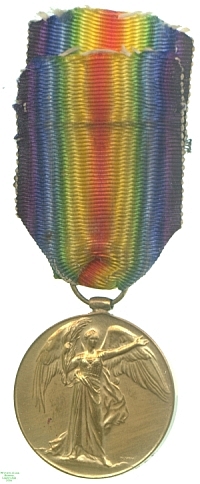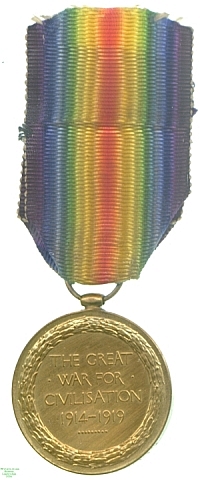
Obverse, Victory looking to the sky and holding aloft a wreath and a palm

Reverse, inscription in border

Obverse, Victory looking to the sky and holding aloft a wreath and a palm |

Reverse, inscription in border |
When the Great War of 1914-1918 had ended, there was a genuine feeling among the victorious Allies that their military efforts had been instrumental in preserving modern civilization, and this and the united spirit of the Alliance were commemorated in a combined issue of medals to those who had seen active service during the conflict. 13 nations in all issued a variety of this medal; all shared the rainbow ribbon and suspension, and all but the Japanese, who lacked a comparable symbolic figure, used a form of Victory on the obverse and a legend on the reverse.
Those who had fought in the British Armed Forces were already entitled to the British War Medal, of course, and if they had served since early on, the 1914 or 1914-15 Stars. The Victory Medal thus became an additional award in Britain, but for many other countries it was the sole badge of participation in the War.
This example was awarded to 2nd Lieutenant John Mitchell, of the Royal Air Force. It is one of a group of eight of his medals that are in the Lester Watson Collection.
Although the catalogue of the Watson Collection considers Mitchell's awards as its Group 7, the medals of that group are not physically attached and so have been treated separately here. Nonetheless it was as a group that Lester Watson purchased them, from the London dealers Baldwin in 1928.